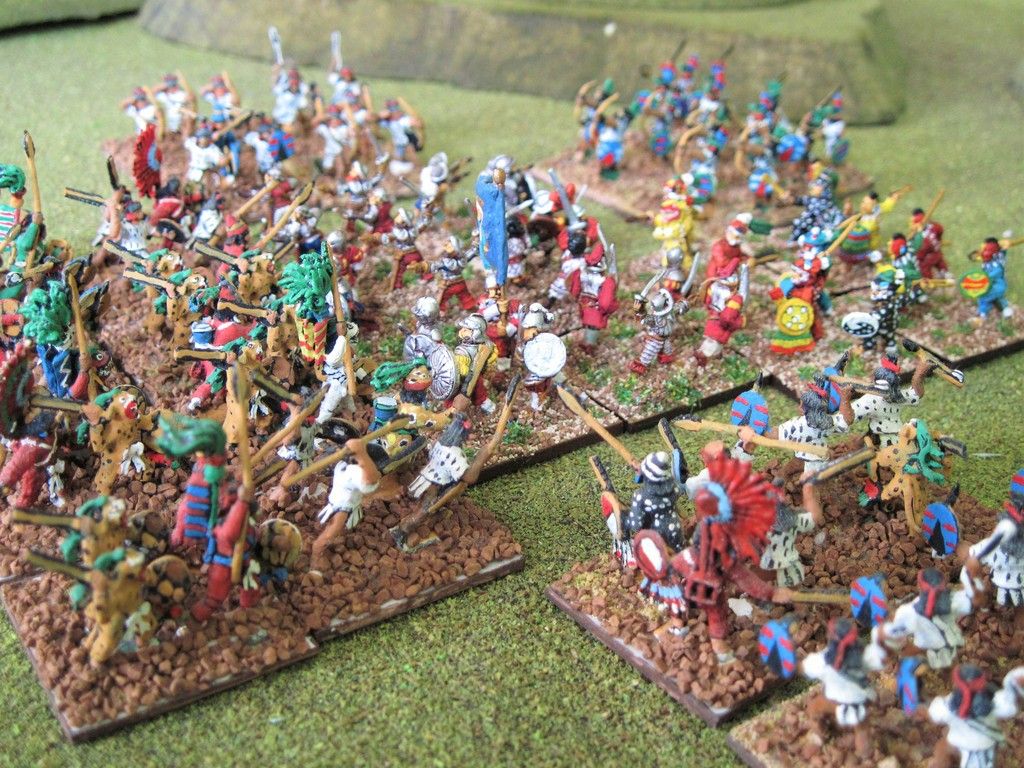Before I post the next play test
I think it worthwhile to quote and
examine a passage from Bernal Diaz. It
describes the first Spanish encounter with the Maya who were a much more serious
proposition than the pretty much unarmed natives of Cuba. That said it is
fairly typical of his descriptions of combat between the Spanish and other
native opponents. The entire action, and
it was an intense one, lasted an hour
“When
their squadrons were formed up they surrounded us on all sides and poured in
such showers of arrows and darts, and stones thrown from their slings that over
eighty of us soldiers were wounded, and they attacked us hand to hand, some
with lances and others shooting arrows, and some with two handed macana swords
and they brought us to a bad pass. At
last feeling the effects of our swordplay, they drew back a bit, but it was not
far, and only enabled them to shoot their stones and darts at us with greater
safety to themselves.”
We learn, as you can see, that the Maya were organised in squadrons and that their numbers enable them to surround the Spanish. Maya missilery posed a real threat and on the back of its effect the Maya attempt to overrun the Spanish. Even at the closest range missilery persists. The Spanish swordplay causes the Maya to pull back and missilery resumes. Both sides are clearly brave and under the control of their commanders.
“While
the battle was raging the Indians called out in their language, "let us attack
the captain and kill him” and ten times they wounded him with their arrows; and
me they struck thrice, one arrow wounded me dangerously in the left side
piercing through the ribs. All the other
soldiers were wounded by spear thrusts and two were carried off alive.”
The Maya are now coming in for the kill, they have identified the Spanish captain and know his death will demoralise the Spanish. Clearly they are now at very close quarters but missilery is still part of their tactical repertoire as we see by Bernal’s wound and those of others. We can note that Bernal's cotton armour could not stop an arrow at close range. The Maya are taking prisoners a sure sign they are winning the melee.
Additional squadrons of warriors arrive bringing a large supply of arrows and food and drink.
“Our
captain then saw that our good fighting availed us nothing. All of our soldiers were wounded with two or
three arrow wounds, three of them had their throats pierced by lance thrusts,
our captain was bleeding from many wounds and all ready 50 soldiers were lying
dead.”
The Spanish captain knows he is getting beat and that if he stays in position all will be captured or killed. The Spanish losses are very high although we are not told which weapons had killed them. We can see that close range archery is effective and that the Maya had quickly identified the throat as a vulnerable unarmoured area.
“Feeling
that our strength was exhausted we determined with stout hearts to break
through the battalions surrounding us and seek shelter in the boats that
awaited us near the shore; so we formed in close array and broke through the
enemy.”
The Spanish are beaten and now
have to make a run for it. They close up,
so clearly they had been in a looser formation beforehand, probably necessarily
so because of the disparity in numbers. Once
in close array they successfully fight their way to the boats although combat
continues until they row to deep water.
I want Have a Heart to be able to reflect this sort of fighting and when
you read the next play test you can judge how well that has been achieved so far. Before that, or maybe after there will be a couple of army lists and some thoughts on how Have a Heart is intended to work.



































